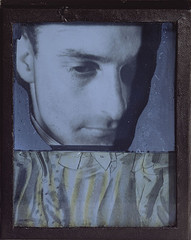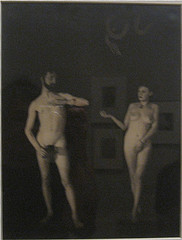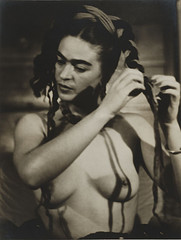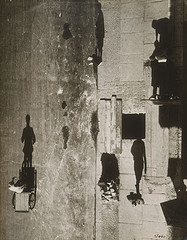
Joseph Cornell (American, 1903-1972), Portrait of Julien Levy, Daguerreotype-Object, 1939. Assemblage with silvered glass, mirrored glass shards, black sand, gelatin silver prints, and other materials, Case: 5 3/16 x 4 1/8 x 1 inches; Frame: 11 x 10 x 2 1/8 inches. Philadelphia Museum of Art; The Lynne and Harold Honickman Gift of the Julien Levy Collection, 2001.photo provided by PMA
Part of the surprise in Dreaming in Black and White: Photography at the Julien Levy Gallery, now showing at the Philadelphia Museum of Art, is how many of the photographs appear fresh, their strategies still part of mainstream photographic practices today. Even the more dated photographs appear as forebears but not dinosaurs.
Some these photos haven’t been seen since they were exhibited at the gallery more than 50 years ago, said Curator of Photographs Katherine Ware, who, together with Peter Barberie, the Horace W. Goldsmith Curatorial Fellow in Photography, curated the show. A mysterious Lee Miller portrait of an avocado pit was even unfamiliar to her own son. A Lazlo Moholy-Nagy was unknown to his own daughter. And a Walker Evans, apparently not previously published, was not known to curators steeped in Evans work, whom the museum contacted. The photographs are culled from a collection of about 2,000 works donated in part by Levy’s widow, Jean Farley Levy, in 2001.
The exhibit of about 200 photographs celebrates the 100th birthday of Levy, who believed that photographs could be sold as art (he was way too far ahead of his time on this, and learned it quickly). He had a fine eye for what was good, and looked beyond U.S. borders for photographers. He gave Frenchman Henri Cartier-Bresson his first U.S. show and Mexican photographer Emilio Amero his first U.S. show. Levy was an eclectic collector who perused the stalls in Paris, searching unsorted, anonymous piles photos, many unloaded by newspapers and sold for pennies. Some of these are also included in the exhibit.

Cine-Sketch: Adam and Eve (Marcel Duchamp and Bronia Perlmutter), 1924, by Man Ray
The exhibit reflects Levy’s taste for Surrealism. My favorite in that section was a Man Ray image of Adam and Eve which was hilarious and gossipy all at once. I must apologize for the picture. I was having technical issues trying to figure out my new camera (still am). But there is a snake in the upper right-hand corner. Fortunately, the PMA press office provided the remainder of the photos.
At a time when New York’s landmark buildings were under construction, cityscapes and skyscrapers and construction shots became subject matter that we still draw on today. The Sherril Schell photos–especially the Construction of Rockefeller Center, Buildings on West 61st Street, and some shots of buildings caught in window reflections–still look fresh.
A closeup of a barn-door mechanism by Luke Swank takes on the heroic strength of the machinery of industry in a Diego Rivera mural. Levy saw an ad for Swank’s photography in the New Yorker and found him working at his family’s Pittsburgh auto dealership, said Ware. Unfortunately the photographer died young and didn’t leave much work behind.
There’s a Laszlo Moholy-Nagy picture of a crowded beach that reminded me of a Brueghel, full of swarming humanity.

Julien Levy (American, 1906-1981), Frida Kahlo, c. 1938. Gelatin silver print. Philadelphia Museum of Art; The Lynne and Harold Honickman Gift of The Julien Levy Collection, 2001. photo provided by PMA
Some fabulous–and unusual–Joseph Cornell constructions, made to look like Daguerrotype boxes, include one with a portrait of Levy himself (see top photo), and one of Levy’s mother-in-law, Mina Loy, looking too young and beautiful to be anyone’s mother-in-law. Also unusual are some prints made by Cartier-Bresson, who after the early ’30s no longer made his own prints. And some fabulous photos by Levy himself of Frida Kahlo, Kahlo looking very like the confrontational persona she projects of herself in her self-portraits, with snaky hair and forthright sexiness.
I also was interested in the photographs of designs for household objects–like lamp shades and wastepaper cans–that Levy himself put into production for a brief time. His interest in the vernacular and bringing photography into daily life is a concept that’s more current now than it was then.
The show deserves a mention for installing a curved wall as a salute to the curved wall in the Julien Levy Gallery, and a red room as a salute to the gallery’s red back room.

Umbo (German, 1902-1980), Uncanny Street I (Unheimliche Strasse I), 1928. Gelatin silver print, 11 5/16 x 9 inches. Philadelphia Museum of Art; The Lynne and Harold Honickman Gift of The Julien Levy Collection, 2001. photo provided by PMA
Divided in three sections–the surreal section on the curved wall, the American section to the left part of the perimeter, and a section that Levy would have called “Anti-Graphic” (happy accident photographs like Cartier-Bresson’s street shots) in the red room but also appearing along the perimeter along with arty shots–the show is too exuberant to be held to its categories, with lots of crossover from one section to the other.
The PMA is also showing a short Friday night series of films made by artists affiliated with the Julian Levy Gallery. Here’s the info.









